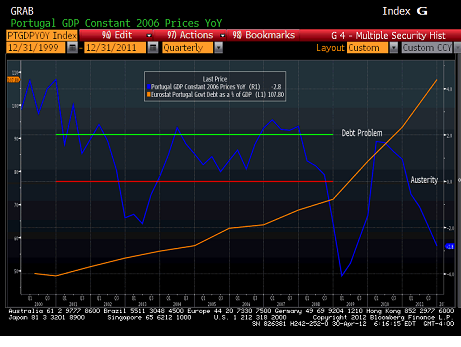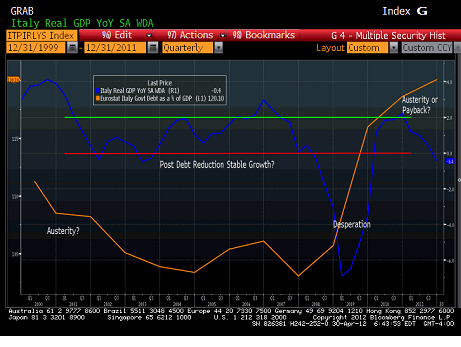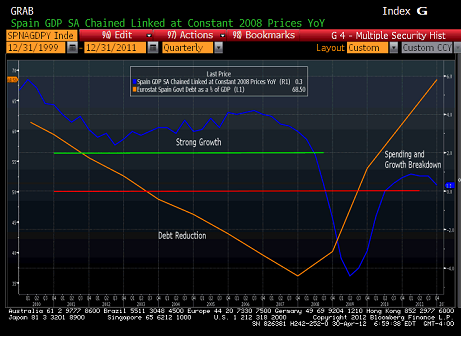What the TF? Give Austerity a Chance. Spending for Growth Already Failed.

The markets may decide to play along with the renewed talk of growth and the death of austerity, but it is shocking how quickly writers and the media have latched on to the idea that growth will somehow save us and that the entire problem is the fault of austerity.
Although it seems like it has been around for awhile, austerity is fairly new. I don’t think Greece even got nailed with austerity until May of 2010. In September 2010 when EFSF and ESM were first officially launched, Portugal and Ireland were both contributing members. The first time austerity was mentioned in Spain and Italy had to be the summer of 2011, if not later?
Until that time, I assume growth was part of the policy of most countries? I find it hard to believe any country engaged in an anti-growth policy? Was not every policy in Europe, up until at least 2010 if not beyond, actually a “growth” policy? Why did they fail to create enough growth to stop the debt crisis?
Ah, that is the other problem. It isn’t just growth that is needed, certainly not to comfort the bond market, it is growth that surpasses the amount spent (borrowed) to create it.
Portugal

So Portugal has been mired in weak economic growth since 2001. It spent most of the decade with growth between 0 and 2% and had two significant downturns. The entire time, debt to GDP was increasing. Was Portugal not “spending” the entire low growth period from 2003 until 2008? It is possible that they kept “spending” to get some “growth” KNOWING that in the future things would be better?
This period is important. There was low growth, yet the debt was increasing at a faster rate. Why? The best guess is that they were spending trying to achieve better growth. It didn’t work. 2008 hit, and growth was a disaster, which led to even more spending, but then growth slowed and took a turn for the worse, even BEFORE austerity hit.
The spending bubble to get through the 2009 period, aided by the global turnaround, failed to create sustainable growth. Portugal was already seeing their economy deteriorate before austerity came into play. Why? Because the debt burden had grown so large that a country with a weak, deficit inflated economy couldn’t afford to maintain.
Has austerity made it worse? Possibly, but the economy did worse in 2009 than it is doing now, so we shouldn’t underestimate Portugal’s ability to outperform to the downside. Peopled seemed comfortable spending for 10 years with minimal results, but a year into austerity (amidst a global slowdown), and suddenly austerity is bad? Portugal took a decade to judge that spending was not achieving growth, and in about a year has decided to go back to that?
And yes, austerity does have a near term negative impact to growth. That was known going into it. In fact it is basic math, so expecting cuts not to result in some economic slowdown is either the result of naivety or being too lazy to do some basic math on GDP calculations. Some austerity measures have a bigger near term impact than others, but to expect no impact, especially in a weak global economy is just wrong. The key is what the situation will be like in a year. Yes, a year is a “long” time, but still, why are we so quick to judge?
On Portugal, it looks like spending to achieve growth failed miserably, and possibly caused the problem, and the rush to the conclusion that somehow austerity is to blame seems premature if not completely incorrect.
Italy
The chart for Italy is much more interesting and may also may make it less clear that austerity is such a bad thing.

Italy started the 21st century with a high debt load. They took that debt load down over a period of years. Initially it dragged GDP down, but then it seems like it supported a fairly stable economy. It didn’t grow at a great rate, and they did seem to try and take spending and debt down during period of above 2% growth. 2008 was a disaster for Italy, as in most other countries. Debt to GDP skyrocketed. It wasn’t because of “austerity” it was to spark growth and stop the slowdown. It kind of worked, as Italy managed to bounce back to decent growth (along with the rest of the world), but the debt level had shot up to incredibly high levels. The slowdown in Italian growth began in 2010 and there was not a word about Italian austerity in 2010. In fact, there wasn’t a word about austerity that had any actions associated with it until Berlusconi left office. But by then Italian growth was anemic. Is the dip into recession all the fault of austerity, or did Italy spend too much and not take enough constructive measures in 2008 and 2009? It looks like they spent far too much on “growth” in that period and are now paying the price.
Maybe Italy needs to look back at what created that period of stability from 2002 until 2007, and determine that a lower debt to GDP ratio is preferable, because the alternative is unsustainable. Once again, after a few years of aggressive spending to get as much growth as possible, that has since failed to achieve sustainability, the politicians should be careful about assuming the current slowdown is all about austerity and not about past “growth” decisions gone horribly wrong.
Spain

This might be the most interesting chart of them all. Spain used a period of strong economic growth to reduce the debt to GDP. That is probably a more impressive case for how growth can reduce the debt, rather than a case of austerity helping growth. The debt to GDP ratio is low in any case, but Spain does seem to push more on to regional governments than other countries and has been a big fan of guarantees rather than actual debt, so that should be kept in mind.
Then in early 2008, growth dropped significantly. It was definitely experiencing problems a bit earlier than other countries. It swung to big declines in GDP that were only reversed when the global economy turned, and with excessive spending – just like Italy.
The weird thing about Spain is how growth failed to take hold in 2010 even as spending increased. In fact, spending continued to increase, yet growth didn’t materialize. It wasn’t again until at least the middle of 2011 that any form of austerity was happening in Spain, yet the failure to “grow” in response to spending occurred earlier.
Certainly some of the same explanations that apply to Italy, apply here, namely that too much money was spend to hide a problem, rather than address it, so growth didn’t follow spending, and now the debt burden is impeding everything. Maybe there is some element of payback for the huge deficit spending designed to get the economy growing again, that just didn’t work longer term?
Spain has the added question of whether the growth in the early part of the decade was too high, and since Spain and Spanish banks have done everything to avoid recognizing the bursting of the property bubble, maybe the downturn in growth occurred much earlier, or the 2008 recession was much worse, and it is only now slowly but surely being leaked into the data.
Spain raises many issues, but after the massive increase in spending for growth in the 2009-2011 period failed to achieve a meaningful growth rate, and let debt continue to pile up, maybe 1 quarter of a new government, whose policies have barely taken force, should be given a bit more time, before embarking back on the failed policies of growth at all costs that have helped create the problem.
Conclusion
Neither spending nor austerity is universally good or bad. Each has short term consequences and potential long term consequences. Bouncing back and forth between them is highly unlikely to produce a useful solution. A plan needs to be developed. It needs to minimize short term pain of austerity while ensuring future obligations that are manageable. Obviously neglected areas where some spending has an incredibly high likelihood of generating more growth than it costs should be targeted, but assuming it is easy to achieve growth is a fallacy. Finding the right investments to get long term growth is difficult. And long term is the key here. Austerity will hurt GDP this quarter, and maybe next. Spending will help this quarter and next, but without taking into account future constraints caused by debt service and debt repayment, the spending will only make things worse. This is a difficult time. It took years, if not decades to create this mess, and will take years to fix, and spending alone won’t help, because growth is not that easy to find. If it was, there would be 1000’s of companies like AAPL, but there aren’t, and it is less likely the government will find growth than companies. Sadly, it seems like the politicians, media, and the markets have latched on to the idea that growth Is the key and is highly likely to be successful. Kicking the can was a disaster for Greece as the situation got worse and worse, and is still awful, and Europe is now heading down this path under the hallucination that they can create growth above and beyond the debt created to achieve it.
